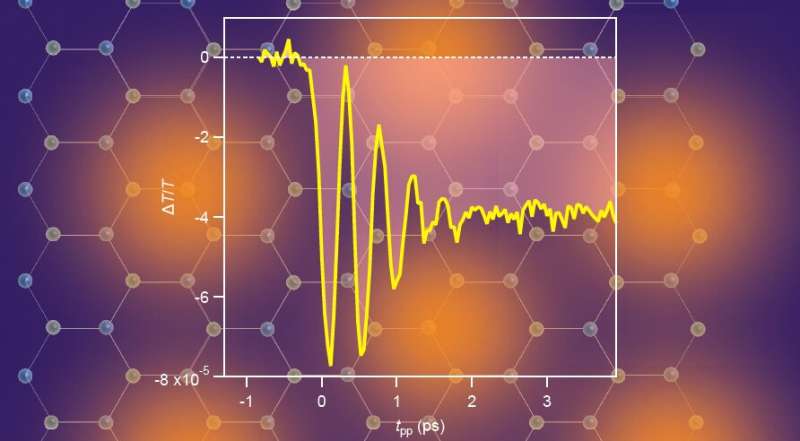July 13, 2021 feature
The demonstration of ultrafast switching to an insulating-like metastable state

In recent years, physicists and electronics engineers have been trying to devise strategies to control or produce quantum states of matter in different materials. Such strategies could ultimately prove valuable for the development of new technological devices.
Researchers at the University of Tokyo and UMR 7162 CNRS Universitè Paris recently introduced a new approach to attain the ultrafast switching of materials to an insulating-like metastable state. Their strategy, introduced in a paper published in Nature Physics, is based on the direct excitation of the amplitude mode of a charge density wave (i.e., amplitudon) via the application of an intense terahertz pulse.
"Our primary interest is to control quantum states of matter by light in an ultrafast manner while avoiding the heating effect." Ryo Shimano, one of the researchers who carried out the study, told Phys.org. "In correlated electron materials, multiple quantum phases including superconductivity, density waves and magnetic orders appear next to each other in their phase diagram. We are investigating the potential of light as a tuning knob for these quantum phases."
In 2013, Shimano and his colleagues succeeded in observing a time-domain oscillation of order parameter in a superconductor, referred to as the Higgs mode, which is a superconducting counterpart of the 'Higgs boson' in particle physics, discovered at CERN in 2012. In 2014, they then discovered that the Higgs mode in superconductors can be directly excited by terahertz (THz) light, via the nonlinear coupling between the Higgs mode and electromagnetic field. The researchers' recent study was inspired by this observation of the so-called Higgs mode in superconductors.
"The question behind our study was: can we expect a phase transition when we drive the order parameter itself in large enough amplitude?" Shimano said. "The phase transition through such a direct control of the order parameter is conceptionally new and intriguing."
As part of their recent study, Shimano and his colleagues specifically examined 3R-TaSe2, a two-dimensional (2D) material in which the charge density wave (CDW) order and superconductivity appear at low temperatures. In their experiments, they tried to drive the order parameter of the CDW directly, without injecting the excess energy into the system by exciting the so-called amplitudon mode (i.e., an amplitude oscillation of the CDW order that is coupled to a phonon), which exists in the THz frequency range.
"We adopted the rather recently developed technique of an intense THz pulse generation and time-resolved THz spectroscopy," Shimano said. "First, we succeeded in driving the CDW amplitude mode through the two-photon excitation process of the irradiated THz pulse. Next, we monitored the ultrafast dynamics of the electronic state with a sub-picosecond time resolution by using THz probe pulse which is sensitive to the charge carriers' response."
Unexpectedly, Shimano and his colleagues discovered that a gap structure was induced in the optical conductivity spectrum in the THz frequency range. This observation suggests that the material's initially metallic state was partially converted into an insulating-like state approximately 1 picosecond after its excitation.
"Usually, irradiating light onto materials tends to induce metallicity since electrons acquire kinetic energy and become more mobile," Shimano said. "The present case is opposite to this common trend: some portion of electrons freeze upon the THz excitation. Since the amplitudon is a coupled mode of electron and phonon, the intense THz pulse should modulate the lattice configuration through the driving of amplitudon."
Based on the findings gathered in their experiments, Shimano and his colleagues inferred that a large amplitude oscillation of the phonon results in an average displacement of the material's lattice, due to the nonlinearity of phonons. This process resembles the rectification effect that takes place in an electric circuit.
The ultrafast modulation of the 3R-TaSe2 lattice configuration could play a key role in enabling the hidden insulating-like state that this team of researchers observed in the CDW system they examined. In the future, they would like to pin down the nature of this insulating-like state, to gain a better understanding of their observations. In addition, they plan to explore the interplay between the CDW order and superconductivity further, using similar experimental methods.
"More generally, our work opens a new pathway for the light-induced phase transition in a 'cold' manner by avoiding the injection of excess energy into the electron system," Shimano said. "We are planning to utilize this new type of tuning knob for the control of quantum phases, aiming at revealing the unexplored landscape of quantum materials."
More information: Ultrafast switching to an insulating-like metastable state by amplitudon excitation of a charge density wave. Nature Physics(2021). DOI: 10.1038/s41567-021-01267-3.
Light-induced collective pseudospin precession resonating with Higgs mode in a superconductor. Science(2014). DOI: 10.1126/science.1254697.
Journal information: Science , Nature Physics
© 2021 Science X Network





















